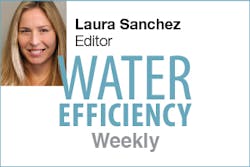Is Dry the New Normal? Facing the Silent Threat of Water Scarcity
Contemporary composer Ashley Fure creates music with water by layering sounds in an arrangement of splashes and droplets. The liquid melody is pleasurable—auditory nourishment, in fact—especially for inhabitants of parched western states.
California residents have their ears pricked for the sound of water as they await the arrival of El Niño and much-needed precipitation. While sporadic winter storms have delivered a moderate amount of rain, hydrologists remain concerned. Some feel that one wet year will not be enough to quench the parched landscape and replenish its reservoirs, not to mention offset the ongoing warming effects of climate change.
Contemporary composer Ashley Fure creates music with water by layering sounds in an arrangement of splashes and droplets. The liquid melody is pleasurable—auditory nourishment, in fact—especially for inhabitants of parched western states. California residents have their ears pricked for the sound of water as they await the arrival of El Niño and much-needed precipitation. While sporadic winter storms have delivered a moderate amount of rain, hydrologists remain concerned. Some feel that one wet year will not be enough to quench the parched landscape and replenish its reservoirs, not to mention offset the ongoing warming effects of climate change. [text_ad] UC Berkeley professor of Earth and Planetary Science, B. Lynn Ingram, warns that climate change means increasingly dry conditions and that preparations for long-term water conservation practices need to be in place. “We’re in a water deficit of at least two years,” Ingram, co-author of a book called The West Without Water, tells Berkeley News. “It’s not likely we’ll come out of this drought. With climate change, California and the Southwest are predicted to get drier overall with warmer weather.” The sound of water’s drips and trickles may become increasingly scarce. Policy makers had hoped that El Niño would bring water to the state before February 2016. As a result, California’s State Water’s Action Plan Emergency Regulation expires at the end of the month. In January Governor Jerry Brown proposed to update and extend the water conservation regulation and urged water managers to prepare for climate change. He emphasized the impact of climate change on the state’s water resources and the importance of applying climate science to water planning. We don’t plan for mid-sized earthquakes, points out climate scientist Juliete Christian-Smith. Instead, we construct buildings and infrastructure that can withstand worst-case-scenario seismic activity. According to her, urban water managers will need to do the same in order to prepare for the certainty of climate change and to ensure a reliable and resilient water system for the future. They will have to prepare for increasing periods of drought. Some hydrologists doubt that one year of above-average precipitation will be enough to make up for the four preceding dry years and/or carry us through a subsequent year of dry La Niña conditions. “Even with a wetter season this year, even next year,” says Ingram, “the climate is very likely to continue to be drier.” Water agencies will have to reevaluate their water sources and storage as well as their conservation strategies. After several years of drought silence, the splash of El Niño’s raindrops and the gurgle of gutter outflow may sound like Mozart to many of us if indeed it arrives. And if not, at least we can seek solace in the sounds of contemporary, human-hewn water music like Ashley Fure’s. Though it may be a suitable sonic substitute, I, for one, will miss the frogs. What sort of preparations for climate change are water agencies in your area taking?UC Berkeley professor of Earth and Planetary Science, B. Lynn Ingram, warns that climate change means increasingly dry conditions and that preparations for long-term water conservation practices need to be in place. “We’re in a water deficit of at least two years,” Ingram, co-author of a book called The West Without Water, tells Berkeley News. “It’s not likely we’ll come out of this drought. With climate change, California and the Southwest are predicted to get drier overall with warmer weather.” The sound of water’s drips and trickles may become increasingly scarce.
Policy makers had hoped that El Niño would bring water to the state before February 2016. As a result, California’s State Water’s Action Plan Emergency Regulation expires at the end of the month. In January Governor Jerry Brown proposed to update and extend the water conservation regulation and urged water managers to prepare for climate change. He emphasized the impact of climate change on the state’s water resources and the importance of applying climate science to water planning.
We don’t plan for mid-sized earthquakes, points out climate scientist Juliete Christian-Smith. Instead, we construct buildings and infrastructure that can withstand worst-case-scenario seismic activity. According to her, urban water managers will need to do the same in order to prepare for the certainty of climate change and to ensure a reliable and resilient water system for the future. They will have to prepare for increasing periods of drought.
Some hydrologists doubt that one year of above-average precipitation will be enough to make up for the four preceding dry years and/or carry us through a subsequent year of dry La Niña conditions. “Even with a wetter season this year, even next year,” says Ingram, “the climate is very likely to continue to be drier.” Water agencies will have to reevaluate their water sources and storage as well as their conservation strategies.
After several years of drought silence, the splash of El Niño’s raindrops and the gurgle of gutter outflow may sound like Mozart to many of us if indeed it arrives. And if not, at least we can seek solace in the sounds of contemporary, human-hewn water music like Ashley Fure’s. Though it may be a suitable sonic substitute, I, for one, will miss the frogs.
What sort of preparations for climate change are water agencies in your area taking?
